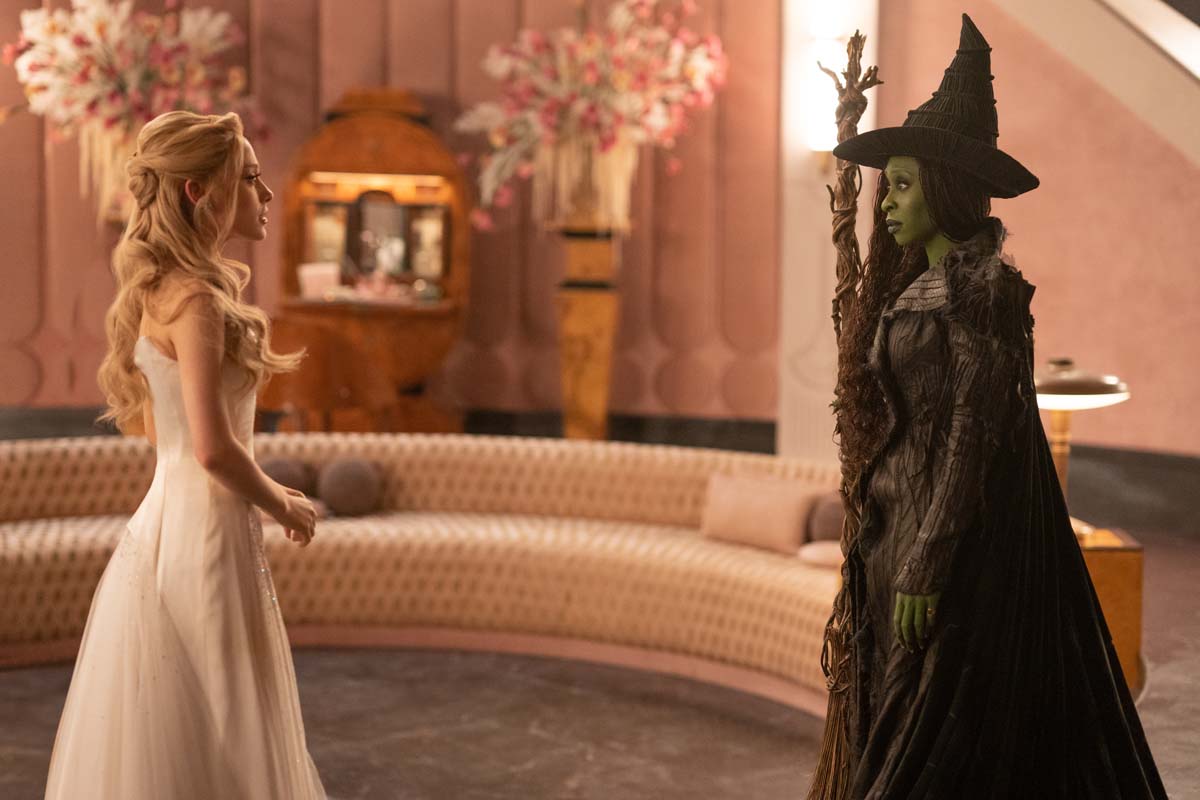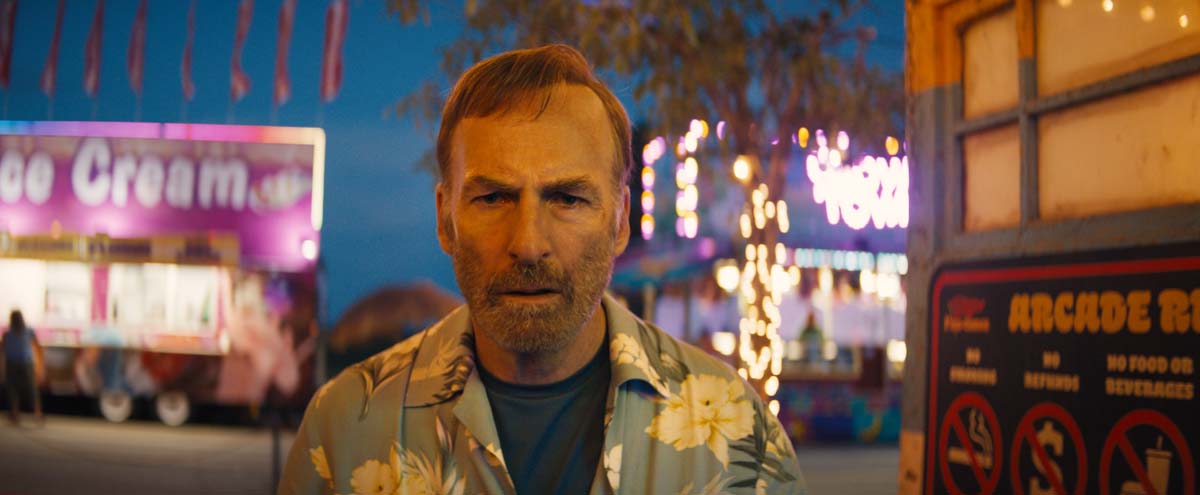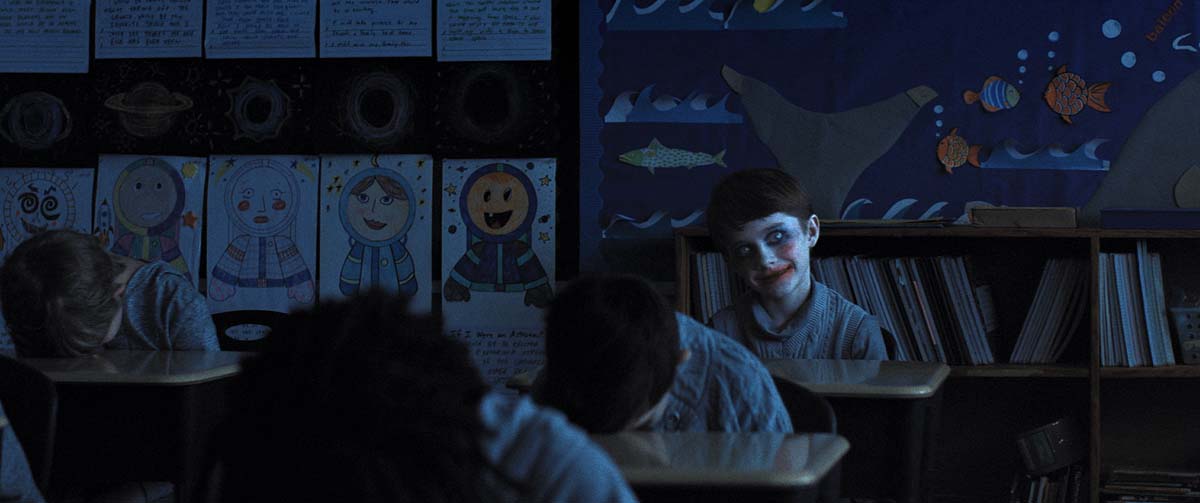Tron Ares
A discussion of the use of previs, building rip-o-matics with Shot Deck, and juggling the power of a score by Nine Inch Nails with incredible sound design.
Today on Art of the Cut we talk with Tyler Nelson, ACE, about editing Tron Ares.
Tyler’s been on Art of the Cut before numerous times including for his editing of The Batman, Creed III, and Mindhunter. He’s also been an editor on Love, Death and Robots and Shadow and Bone.
Tyler, I think I’ve known you longer than I’ve been interviewing you. I think we met at Fincher’s post House years and years and years ago. That was a very Adobe Premiere-heavy shop. Can you talk to us a little bit about what this movie was edited in and what has been your history and preference about NLEs?
Yeah, we’ve done quite a few interviews, haven’t we? It’s fun to recount every time that you and I have had conversations. Some of the first projects we talked about were actually Final Cut Pro. David Fincher’s cutting room was Final Cut Pro, then it became Premiere. At the end of the day, a tool is a tool.
I try to find the best tool for the respective movie as I’ve moved away from working with that team. It seems like a lot of the people that I’ve been interacting with prefer Avid as the “industry standard” NLE.
I know that when I’m working on bigger projects, there are going to be people that come and go for various reasons. In some cases we need to scale up quite rapidly. In these cases, the thing that we need to always look at - as filmmakers - is how can we be the least disruptive when flexibility is needed?
I’ve found myself working pretty much exclusively in Avid since, Mindhunter, which was my last episodic project cut in Premiere. I’ve gone onto edit a couple TV shows cut in Avid and, various features cut in Avid as well.
I love Premiere, and if I were given the option, I probably would have chosen Premiere for Tron just based on how I feel about it, especially when it comes to the visual effects workflow and its integration with After Effects.
My first assistant editor, Russell Anderson, is also a Premiere guy, and I knew that if we chose to go with Premiere, he’d be completely nimble and excel in a lot of different ways.
However, just the nature of what the industry is like and searching for VFX editors and other assistant editors along the way - not everyone knows Premiere, so it was just the smartest choice to go with Avid.
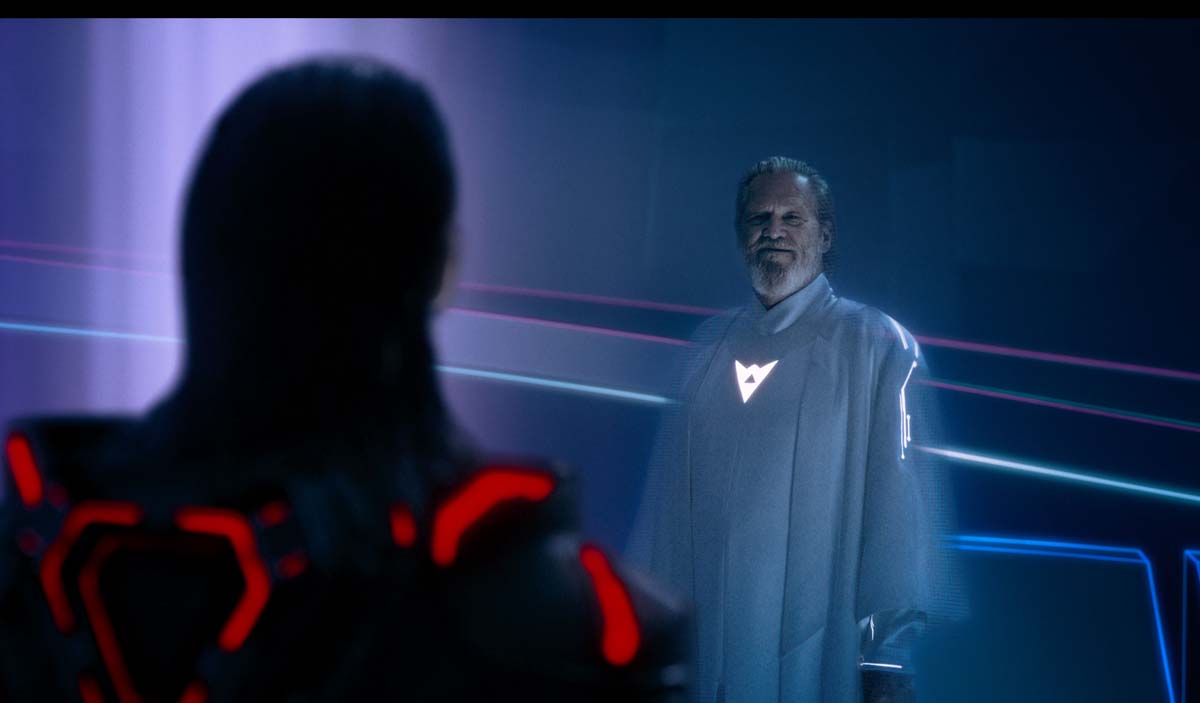
You worked on House of Cards on Final Cut Pro, then that eventually went to Premiere. You were really doing some exciting technological things with bringing in metadata and automating workflows in Premiere back then.
Yeah. That’s actually the thing that we love about Premiere. You can look under the hood and control things a little bit better by exporting data to XML files, manipulating those XMLs, extrapolating information from other pieces of metadata - like if you’re shooting RED for instance, you can really pull in a lot of RED metadata into those XMLs and integrate it into your project.
You can also do a lot of interesting scripting things. I had a piece of software that my former assistant editor, Billy Peake and I sold. We had this really amazing way of automating VFX turnovers and importing VFX shots back into Premiere and automatically naming them and automatically placing them in the timeline. All you had to do was check the work to make sure that the tool was doing what it needed to do. Sadly, I haven’t been able to use that on a project since Mindhunter.
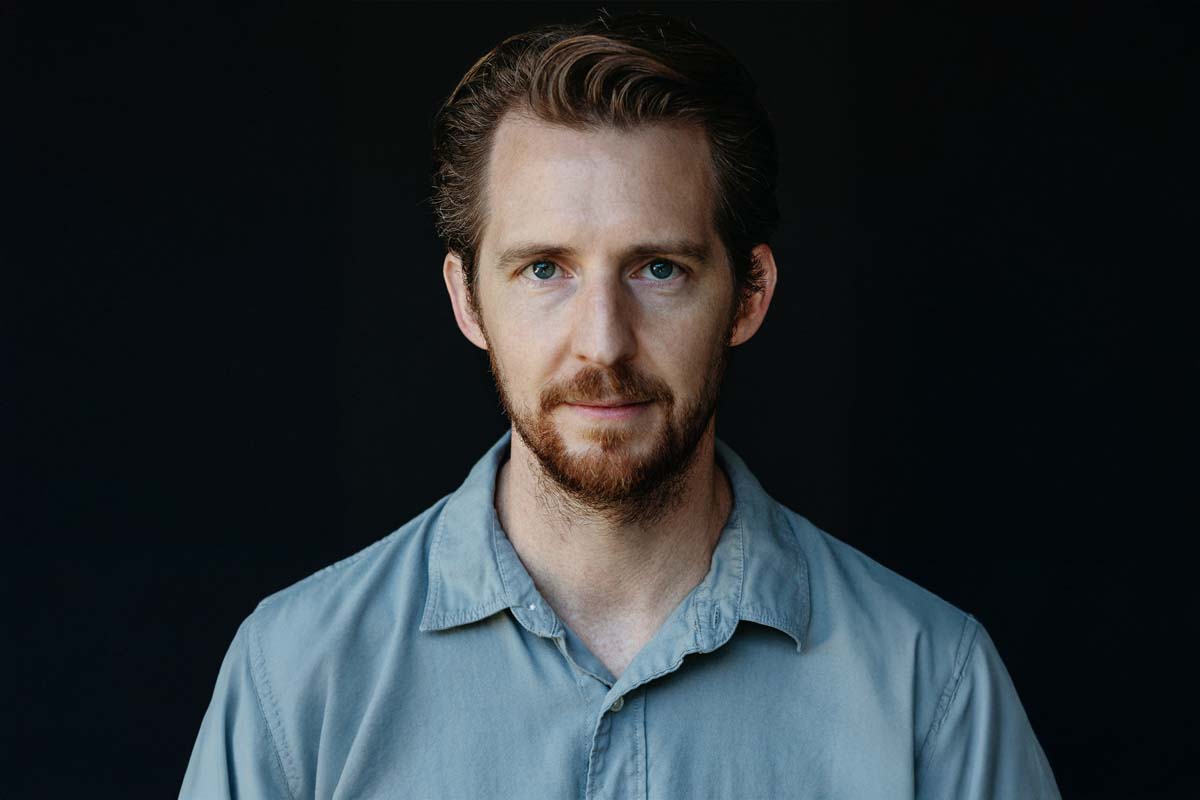
Editor Tyler Nelson, ACE
How did this opportunity come up with this director? You just you cut The Batman and some big projects. Obviously, you’re a well-established editor. How did he decide on you?
I tried to sell myself the best I could. I heard about this project from a friend of mine, Yama Cibulka a VFX coordinator that worked with me on Creed III.
He mentioned that he was working on Tron: Ares, and he was really excited about the project. When I saw his enthusiasm, I was reminded of this experience I had when I was a kid. My parents didn’t really buy a lot of VHS tape.
They recorded them off TV, so I have this really fond memory of being in elementary school or middle school watching the 1982 version of Tron with my friends and my brother, and just loving that world. I just fell in love with Tron.
A few years later, I was working in Hollywood with a lot of amazingly talented people. One of those people is Angus Wall, who was originally tapped to edit Tron Legacy. I was invited to join that team. Unfortunately, that only went as far as helping out with camera tests.
I saw a glimpse of what Legacy was but I didn’t have the opportunity to pursue it further. But I remember watching what director Joseph Kosinski did and what Jim Haygood, the editor, did with that movie. I felt like I was a kid again, so when Yama, told me about Tron: Ares, I wanted a glimpse of that world again.
I told my agents that I wanted to explore this. I know Jim Haygood through his commercial company, Union Editorial, and I reached out to him and said, “Jim, I know it’s been a while since we worked together, but do you feel comfortable putting a good recommendation in with the producers?”
Then I know Jeff Cronenweth, who is the cinematographer on Tron Ares. I’ve worked with him on I think four projects. I texted him and asked, “If you’re ever chatting with Joachim, the director, please drop my name.”
I don’t know how much time passed - maybe 2 or 3 weeks later - I got an email saying that they’re sending the script and it all started from there. Just me pursuing it. I had an interview I impressed upon Joachim that I was a fan and I could do a good job, and he hired me.
I found myself invited on the team. Unfortunately, there were the strikes, so my joining the team wasn’t immediate by any stretch of the imagination, however, because I had my friend from the VFX department, he said, “Hey, we’re having some issues cutting previs sequences.
Do you think you can join early?” So I joined to help out with previs and we had a really fun time cutting all these amazing sequences prior to photography, spending a lot of time honing ideas and coming up with new concepts and beats and shot structure ideas.
It was a really amazing time working from about June of 2023 to the end of that year, before photography at the beginning of 2024.
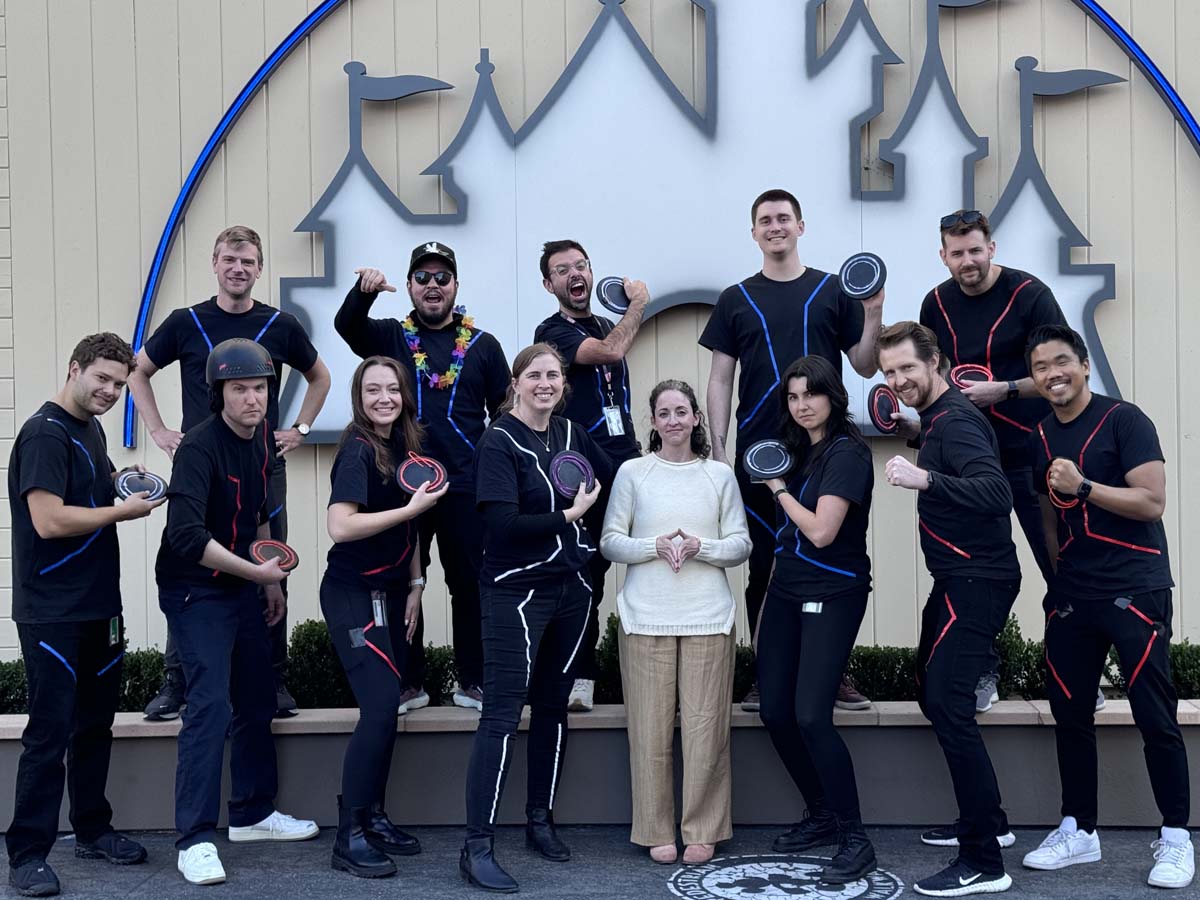
Post team for Tron Ares. Front Row: Young Hall (VFX Assistant Coordinator), Russell Anderson (1st Assistant Editor), Taryn Habel (Assistant Editor), Lauren Gorski (Creative Executive), Samantha Lyn Dickinson (Associate Producer), Samantha Sanchez (VFX Coordinator), Tyler Nelson (Editor), Michael Vu (Assistant Editor). Back Row: John Carner (VFX Editor), Yama Cibulka (VFX Production Manager), Eddy Garcia (VFX Editor), Collin Miller (VFX Coordinator), Nicholas Fitzgerald (Music Editor)
Tell me about your collaborative relationship. You’ve worked with many big directors, and they probably have different collaborative styles. Talk to me about getting used to somebody new.
I was a little bit taken aback by our first couple interactions, because unfortunately, we were all working remotely and I didn’t have that opportunity to really introduce myself. From the point that I interviewed in May, I didn’t actually meet Joachim in person until the next year, in January.
We never set foot in the same spot, so it’s really hard to form a relationship with somebody and understand their energy - how they’re reacting to certain things - and also their style. Especially when you’re working with previs - Joachim was reacting to ideas presented by a company that he’s not overseeing directly.
They’re kind of based on storyboards that he’s been working on, but If it’s an idea that is not 100% what Joachim wants, he’s not going to react positively to it. So my first couple interactions left me wondering if it he was reacting to my edits or the previs itself. Is my reputation on the line because of what this previs company is doing?
They weren’t do anything wrong necessarily. They were just doing something that was not what Joachim had designed. So there were growing pains along the way. However, once we got past those growing pains, it was really fun to present ideas to him. I’d find myself sending a lot of emails, like “I know you’re highly influenced by this film. What if we did this and that?”
One thing that I use that’s an amazing tool I’ve successfully used in a couple projects is Shot Deck. A cinematographer created this website for visual references for pitch decks or look books. I use it for “board-a-matics” to come up with ideas.
It was really useful to come up with ideas of: “What if we go from this shot to a shot like this?” I also explored some “rip-o-matics” finding clips from different movies and inserting those into the previs, then eventually having that replaced with better looking previs that actually matches the look of our sequence.
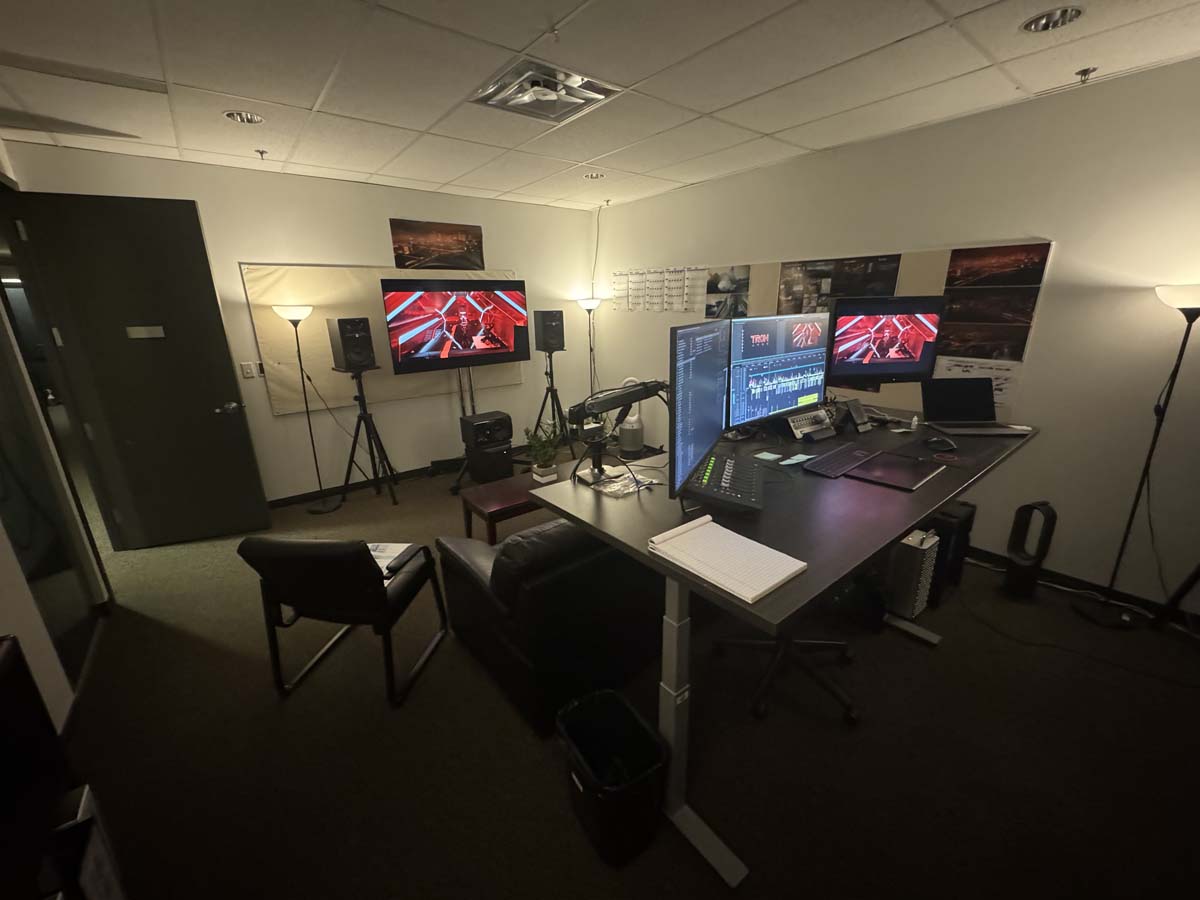
Tron Vancouver cutting room
It was really fun to see this relationship develop and how Joachim started to trust me. By the end of our time working on previs I think we were singing and having an amazing time working on these visual sequences.
That just springboarded us into working in production. Then it was a real learning process as we transitioned to working in person, not remotely. I’d visit him on set and we’d look at sequences that I put together, having conversations and understanding the breadcrumb trail that he was leaving for me through his script notes and his intent for different footage.
It was an evolution. But at the end of previs, through dailies, the director’s cut, through the whole film, we built trust and we were able to lean on each other for ideas and support along the way. It was it was really fun. I had a great time working with him over the course of nearly two and a half years.
From top to bottom - from the studio to all of the peers on our team - everybody was absolutely astounding. Everybody was wonderful to work with, really supportive. We all just wanted to make the best thing possible and everybody was fun to work with from day one to the premiere.
There were a couple of heavy-weights that you got to work with on this. Pietro Scalia was credited as an additional editor on Tron Ares, and Roger Barton, who works as a consulting producer on Disney projects is another well-known editor.
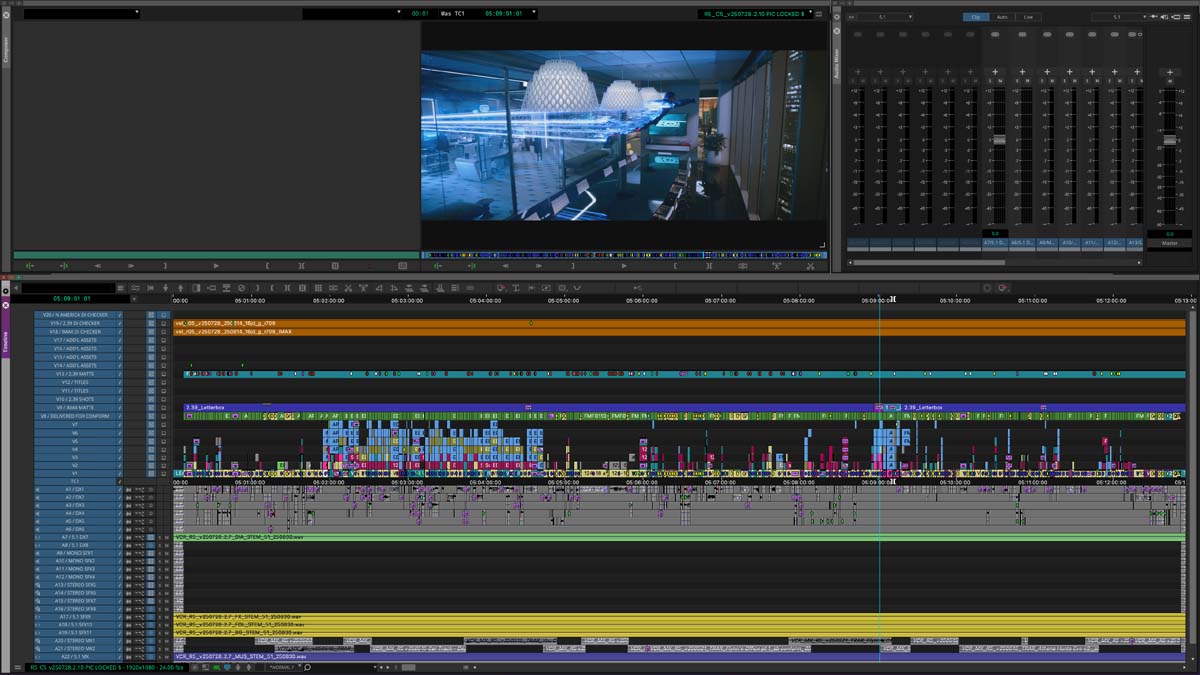
Portion of the Tron Ares Avid timeline
Pietro was the first to come on for about ten weeks. Midway through the director’s cut, Joachim and I were working through a ton of footage and hadn’t had a chance to really go through every single scene. About 2 or 3 weeks into director’s cut, he realized we are only so far into the movie and we were going to need some extra help, so he asked the studio for an additional hand.
Pietro came on and was a great collaborator. I had built the first cut, and had been working with Joachim over the course of a couple of weeks. I started passing sequences to Pietro, and he was a great asset for us.
He started out working remote. Our director’s cut was actually in London. Joachim lives there most of the time, so my assistant editor and I followed him after photography. Pietro joined us about 2 or 3 weeks later to be in the same facility as us.
So we had a really fun time working in London together to hone Joachim’s vision for his director’s cut. After we presented the director’s cut, Pietro had done his job and he left to work on a different project. Pietro was a great asset along the way.
Similar story with Roger. He works with a lot of Disney projects and comes on to help present ideas. He had worked with Joachim before on Pirates I think, and maybe Maleficent as well. His role from the studio standpoint is to come in with fresh eyes and present new ideas.
He came on later in the process to help out with different ideas, especially right before previews to experiment with new things. He was great. He presented ideas to Joachim. Some of those ideas we took and some we disregarded.
Sometimes we used them as a springboard for crafting different versions of sequences. He’s a great guy. Very talented editor and provided a lot of support for our movie.
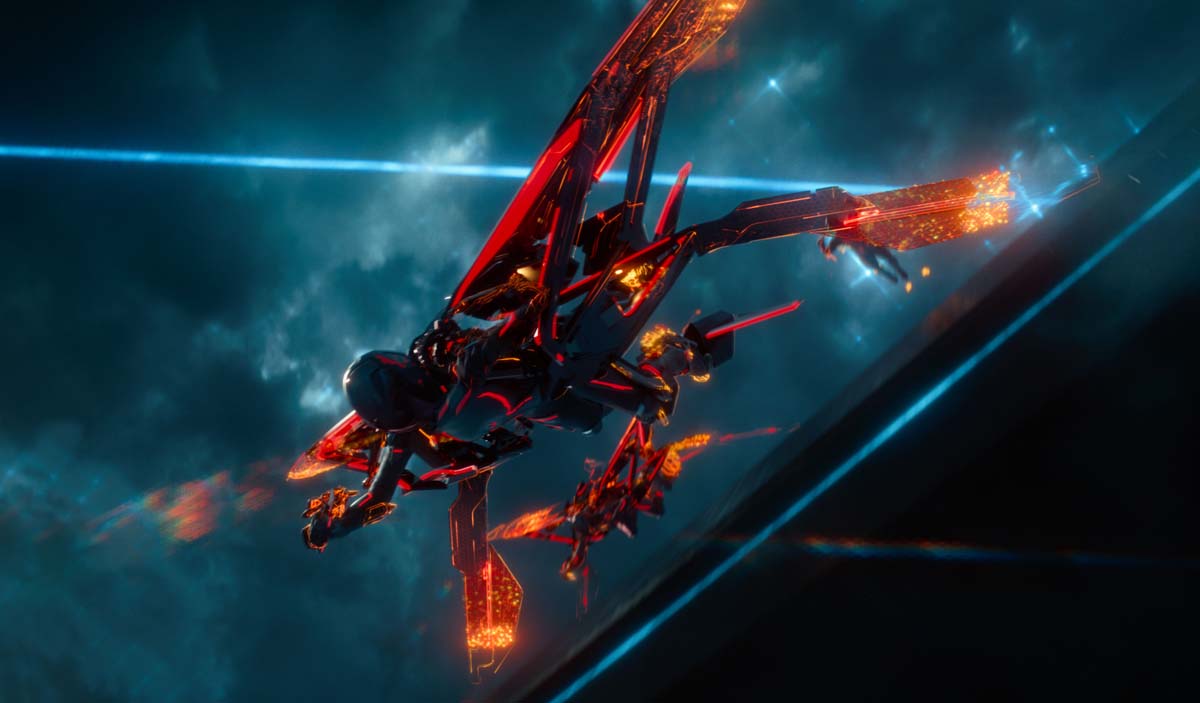
We’ve talked about the importance of previs. I wanted to talk about the opening motion graphics that kind of describe the history of computer technology. It was clearly done by graphics and VFX folks, but I wanted to know how much work you had to do as an editor to set the pacing of that and choose the visuals that would be eventually created by the VFX team.
The opening sequence was actually a late addition to the film. The original start of our movie was oblique typing - which is in our movie - from a figure which ends up being Julian Dillinger.
He’s coding the first couple lines of code which is to become Ares - then once he presses enter, the cursor explodes and becomes the opening of Ares’ eye, then we go from there.
That was the original start of the movie. However, as we tested it, we learned that the people who didn’t know the world of Tron were confused. It was decided that we needed to hold their hands a little bit. So the idea of this news montage came about - which was originally a lot more expansive - talking about the history of technology.
We even had a cut called “The Luminaries Cut,” which was essentially all these great minds in computer technology and artificial intelligence talking about different things. Ideally, it would start from Alan Turing, however, I don’t think there’s any recordings of Turing, so we started collecting quotes from Stephen Hawking, Steve Jobs, Bill Gates, Sam Altman, Elon Musk, the Godfather of AI: Geoffrey Hinton.
We came up with all these different little audio snippets to fill us in on technology and its evolution, but also telling the story of, Kevin Flynn - who he was and what he means to the world of Tron.
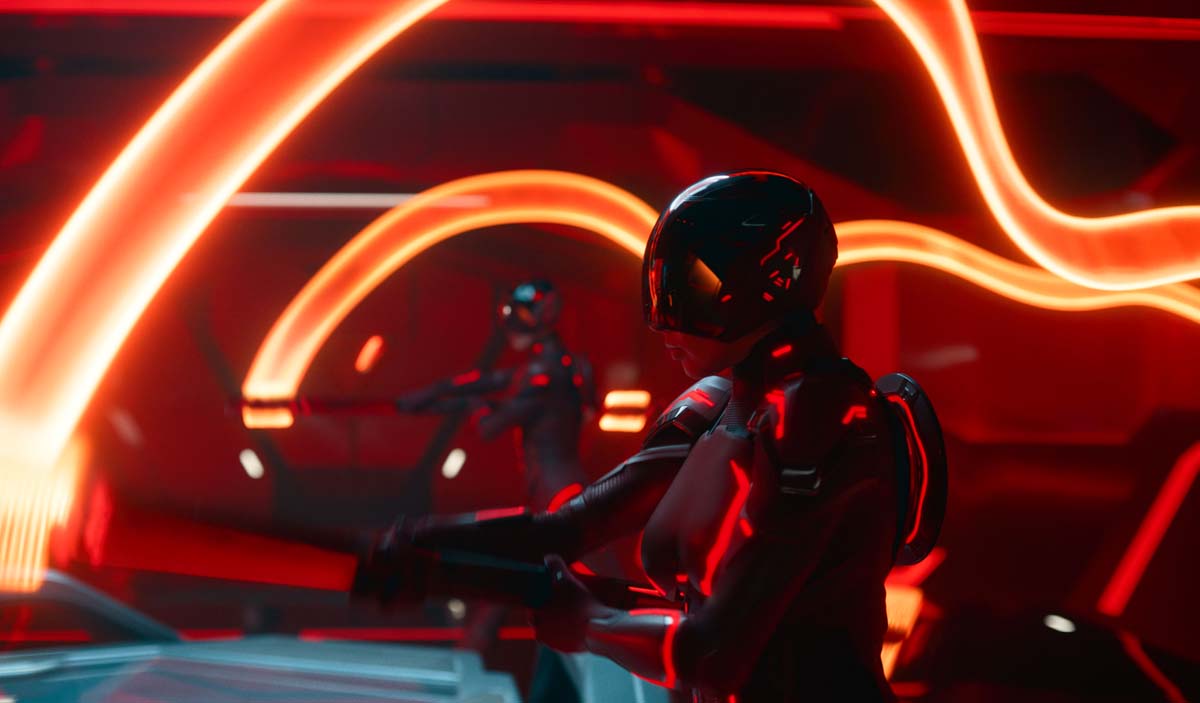
It worked surprisingly well, but it was still a bit unfocus and not specific to our movie, so we eventually simplified it into how it starts our film. It’s basically echoing what was done in Legacy, starting with the words of Kevin Flynn in an interview talking about who he is, what happened to him, the evolution of his company, then talking about Encom and the Kim sisters, Julian Dillinger taking over as CEO for Dillinger Systems, teeing up the race against Encom for AI supremacy.
It was a big evolution, but it all started with a board animatic, which was then replaced by additional photography of actual reporters talking about the world of our film. That was then sent over to a VFX company to do their work.
There’s so much VFX stuff. What were you cutting with beyond what was shot as dailies?
It was tricky in some cases. We used previs where it was necessary, where there weren’t plates for visual effects shots. There are a lot of full CG shots in this movie. There are a lot of augmented shots that required postvis too. We did have a posvis vendor that helped out along the way, but we also had an amazing in-house team.
My first assistant editor, Russell Anderson, knows Blender, and we had a great opportunity to take the 3D assets that the art department had and start integrating them into the world of the film. We had a recognizer. We had Lifecycles.
We didn’t have light wall assets, but Russell modeled light walls and comped those in. We added helmets to characters that weren’t wearing helmets too.
It was kind of amazing to see what he was able to do in-house. We had another amazing VFX editor, Li Mary Ma, who blows my mind what she was capable of doing. The photorealism of what she pulled together! It was amazing to have all these people working to polish the film in those early cuts.
They had little tutorial sessions where other VFX editors would come in and help put other helmets on or add light walls. It was really fun to have all these people right down the hall from me, able to enhance the visuals of our movie even in director’s cut.
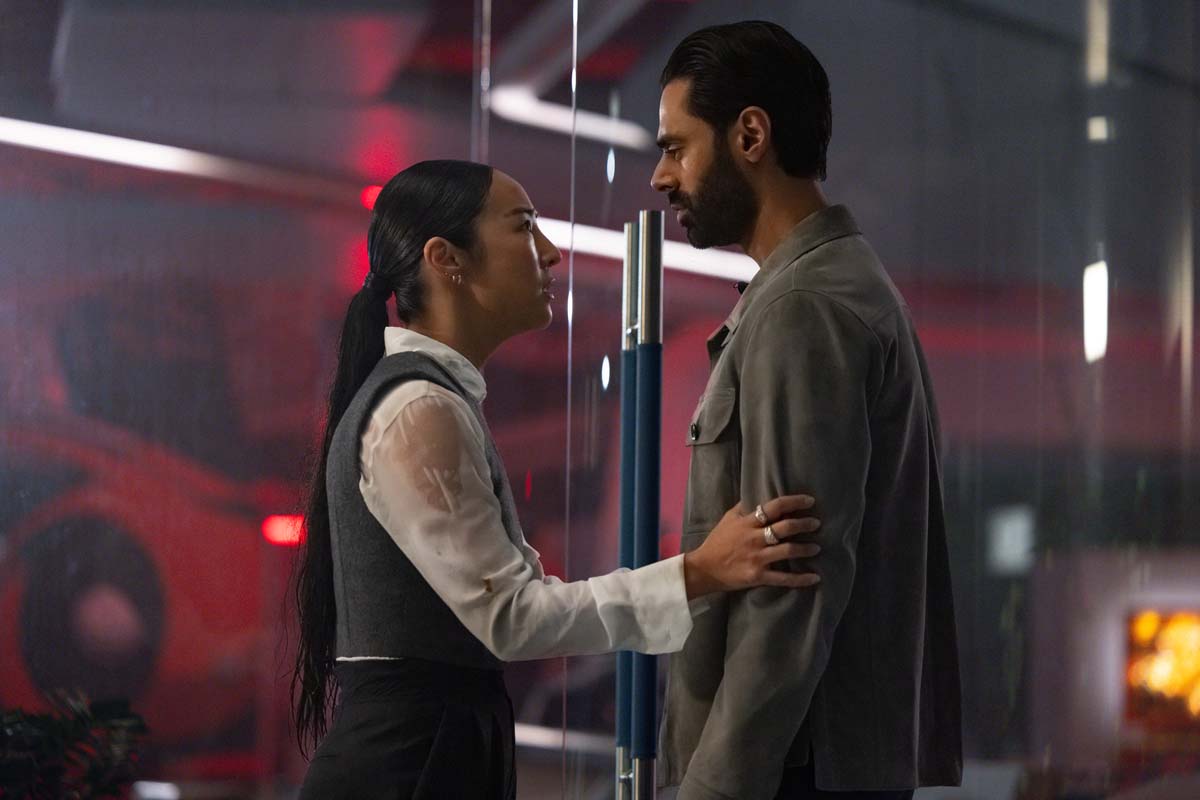
Do those things help give you a better sense of the story? Or better sense of how long something’s going to take to reveal or understand?
For sure. Having something that’s reminiscent of what you hope it’s going to look like and feel like - there’s no better tool than that. It was nice to know that we had a team to flesh out the world to tell the story - to sell the idea to the directors and the producers to make sure that this is what it’s going to look and feel like, even though it’s going to eventually be replaced with a comp from another vendor.
You worked on huge VFX movies like The Batman, so you’re no stranger to a movie with VFX, but did something with this much VFX cause you to change your approach to cutting a scene that is predominantly VFX?
In short? Yes. Yes it did. This is a tricky one to answer because each sequence has its own unique storytelling. For the light cycles we had actual physical proxy bikes that they were racing through the city that had interactive lighting, so that was pretty simple to know that they’re going to reskin them and replace the stunt riders with Eve, Athena, or Ares. Those were the easy ones because what you saw is what of what you were going to get.
There were other sequences along the way where you really needed to think about what you’re seeing and for how long. One of those - the trickiest one - was called “Ares studies Eve.”
This is right before the light cycle chase, where Ares is searching Kim’s files in what we referred to as the Red Room. We get just an onslaught of data from her life: videos, text message, threads - and it’s all surrounding Ares. He’s sifting through the files.
Different images and videos are moving towards him. We were using Avid’s 3D warp tool to temp in what needed to be there, but as soon as you saw all these amazing visuals we felt like we needed to extend shots so we could absorb them as much as possible.
It was a sensory overload. One thing that I wish we had more time on was absorbing all the textual data that we’re seeing because there are some amazing story moments in there that the audience is probably missing. That VFX sequence was really hard to conceive because there was really nothing there on set.
There was also the sequence that we called “Ares wakes up” when he has just been programmed and is going through the process of learning and training - and dying multiple times.
That was a much longer sequence at one point. It has a very different feeling being on blue screen versus being in a fully rendered mirrored room. It was really hard to understand what that sequence was going to be without spending a ton of money on finishing visual effects shots.
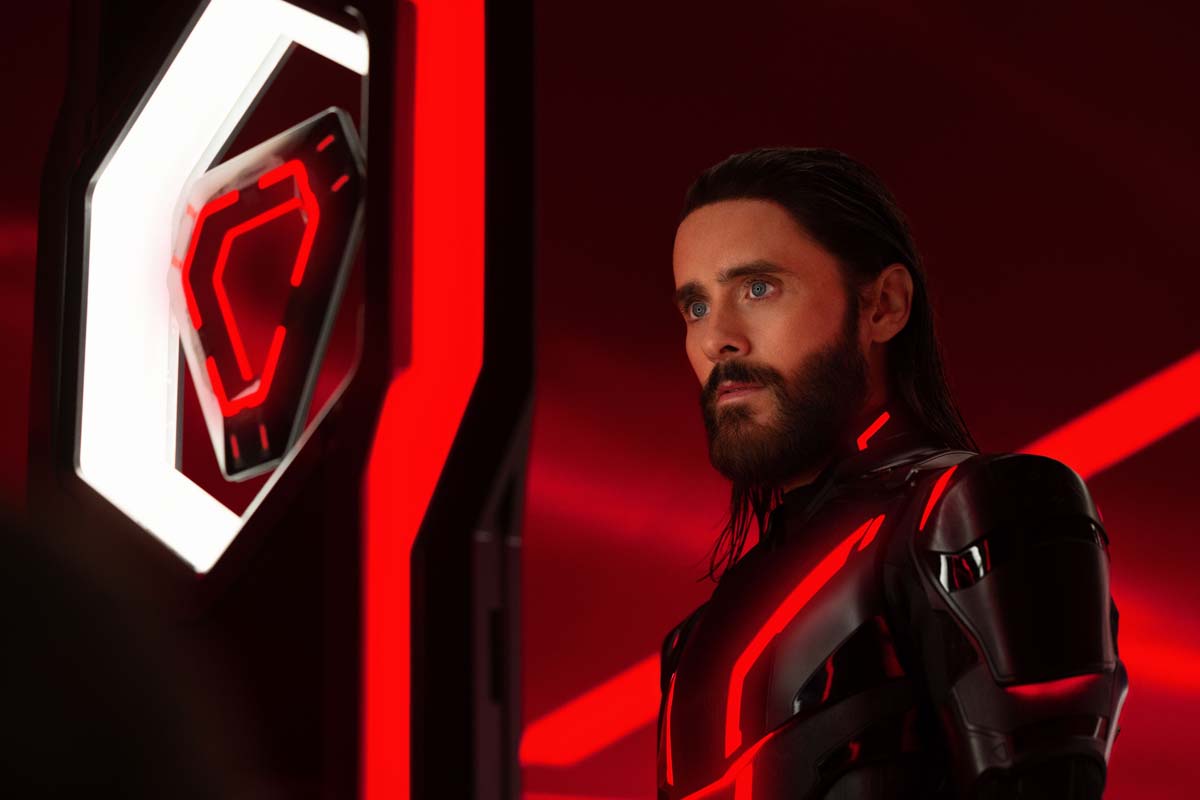
As you mentioned, the “Ares studies Eve” scene could have shown so much more of her life, and given all kinds of clues to her character, but at some point, you also have to say, “We can only allow so much of this.” There’s the budget of it, but there’s also just the pace of keeping the movie moving forward. I would think that would’ve been really hard to decide how long that scene should be.
Yeah, it was much longer. Everything starts out long doesn’t it? Then you trim it to make it feel right. There’s definitely a script, but when you have a sequence that is basically a clean slate of Ares walking around an empty room, you can explore new territory and come up with new ideas. Some of those ideas got stripped away from the script, and some things were added.
Like the story of Tess Kim. People needed to know more about what happened to her and what her relationship was to her sister, Eve Kim, so we shot more scenes and put them in there to tell the story of her death.
That was all changed and enhanced to not only give it a little bit more emotional weight to the relationship with her sister, but also because the audience needed to know who this person was. Details were added along the way, but as I said, because it was a blank canvas the possibilities are endless.
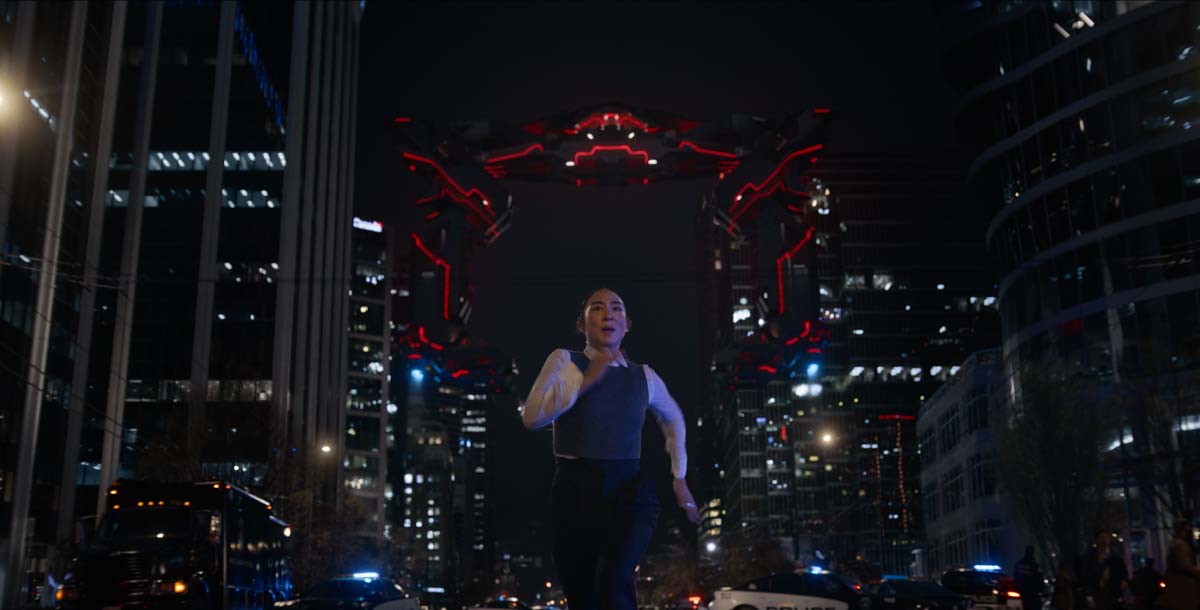
How do you go from building the first version of that scene to getting it to the final version of the scene where you’ve got final visuals from ILM or whoever the vendor is? What’s the evolution of that process of getting you from dailies and some previs to a finished scene?
A lot of support from my team. A lot of these sequences had storyboards that corresponded with them, but if we did previs them, then we had that material as well.
But then I also dipped into this idea of extrapolating ideas from other movies or using Shot Deck, and gave that to my team as reference material to either re-do in Blender or try to do a better VFX version of it.
It was a collaboration with my amazing assistant editors and VFX editors to help polish those things along the way. It would be a back-and-forth until we really got something we liked. Then we’d present it to the director and it would evolve from there.
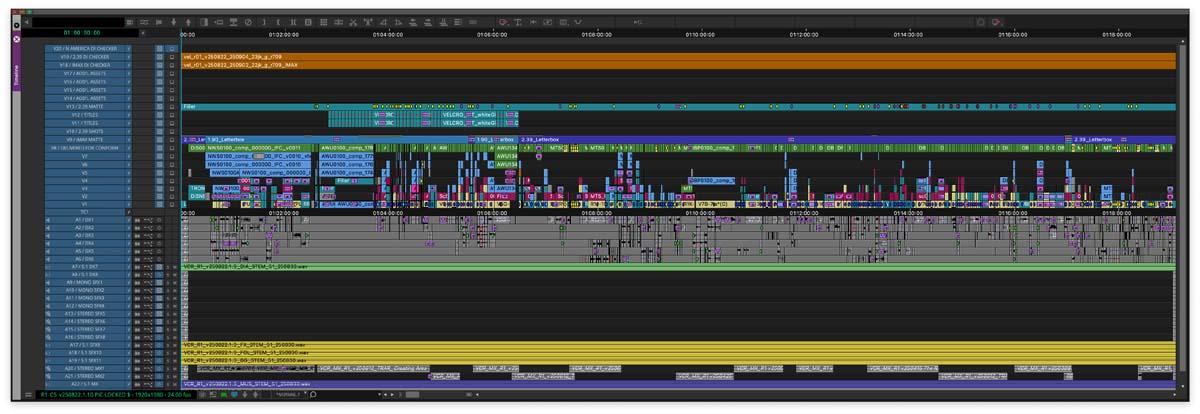
Segment of the Tron Ares Avid timeline
We were on this movie for a long time, so there was a lot of waiting for visual effects to come back to us - especially for the big VFX sequences. There was a lot of cutting along the way. Some sequences were massively slashed based on rhythm, cadence - whatever was the issue - swapping takes, shuffling. It was an evolution.
One that was a little bit tricky is the third act, which is a lot of intercutting between what we refer to as the Flynn Grid - the 1982 grid - and what’s happening in the real world. A lot of those scenes were kind of like a checkerboard.
We could shuffle them around and move them wherever we needed to, based on how they handed off against one another and what was happening in the 82 grid.
A lot of those Flynn and Ares scenes got shortened drastically because of how they slow they were in comparison to the real world.
Your job as an editor never stops. As you’re waiting for visual effects to come back to you, the only thing you can really do is polish it as much as you can in-house or with a postvis company, then wait for the real visual effects and hope for the best.
I got to see this movie in a theater with a great sound system. I would recommend that to anybody who sees this movie. Can you talk a little bit about the soundtrack? And by “the soundtrack” I don’t just mean the music, but the entire soundscape of the film and how that evolved.
The sound for this movie was really important. The visuals are obviously very important because a Tron movie needs to have these astounding visual effects. The second movie had the Daft Punk soundtrack that was astounding, so we knew we needed to have not only just a visual experience, but it needed to be an auditory experience as well.
It’s a double-edged sword, because Daft Punk no longer exists - and everybody loved that soundtrack - so there’s not an opportunity to explore having Daft Punk return and do an amazing soundtrack for this movie. But because they weren’t available, Nine Inch Nails was. That was fun to have them around as the team doing the soundtrack.
For the sound design aspects of things we had an amazing team. There was Addison Teague who was the sound designer on Legacy, along with Tormod Ringnes and Baard H. Ingebretsen who are the Norwegian sound designers and rerecording mixers who Joachim has worked with on many, many movies - I think way back to film school days.
So we had this amazing team working in tandem to create all these amazing soundscapes, working on different sequences. So collaborating with them and getting different ideas from them and incorporating those into our offline edit was so fun.
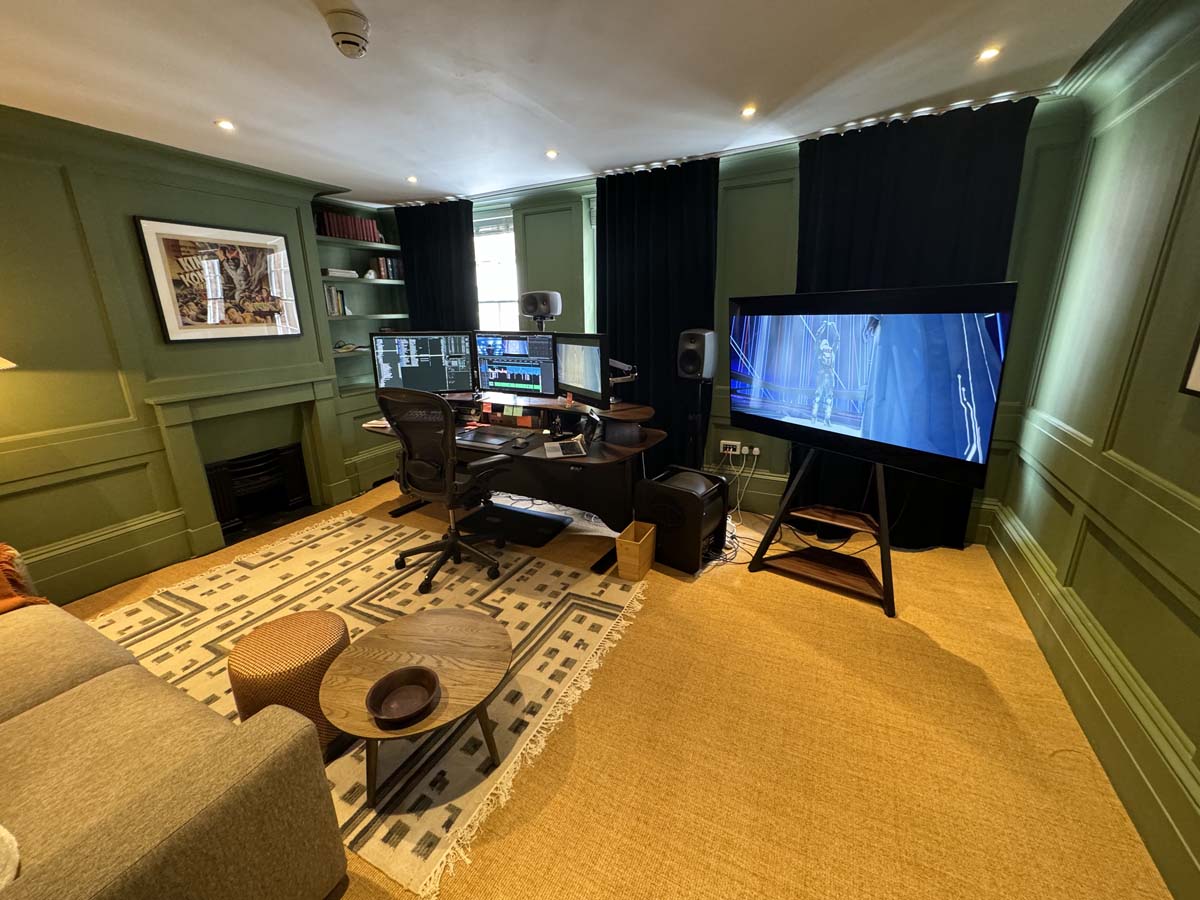
London cutting room
Unfortunately, we didn’t get any soundtrack from Nine Inch Nails until late in the game, so we were temping with a lot of older Nine Inch Nails cues and also Tron Legacy music.
Once we started getting tracks from Nine Inch Nails, we had to rethink the soundscape in a lot of ways, because the sound design had been doing a lot of the heavy lifting in sequences like the light cycles, but once we started getting tracks from Nine Inch Nails, they weren’t complementing one another.
They had to completely adjust their soundscape to support the delivered music, to make sure that the sonic experience was united. There was a lot of stuff coming in along the way that was helping all those sequences come to life.
Then Atticus Ross and some of his team went in with our rerecording mixer and started really molding the sequences together. So it was really a nice united front to make sure that the light cycle chase sounded beautiful.
What were you monitoring with in your cutting room, sound wise?
We cut in 5.1. We had the great fortune of doing some temp mixes along the way, so we were able to carry 5.1 stems in some sequences, but for the most part, when we were working with stems it was mostly L-C-R with the occasional 5.1 stem in there to make a sequence really pop.
There’s an extended sequence near the end of the film where one of the protagonists, Eve Kim, is, being chased and you’re cutting back and forth between various elements. Can you talk about how the intercutting of that worked?
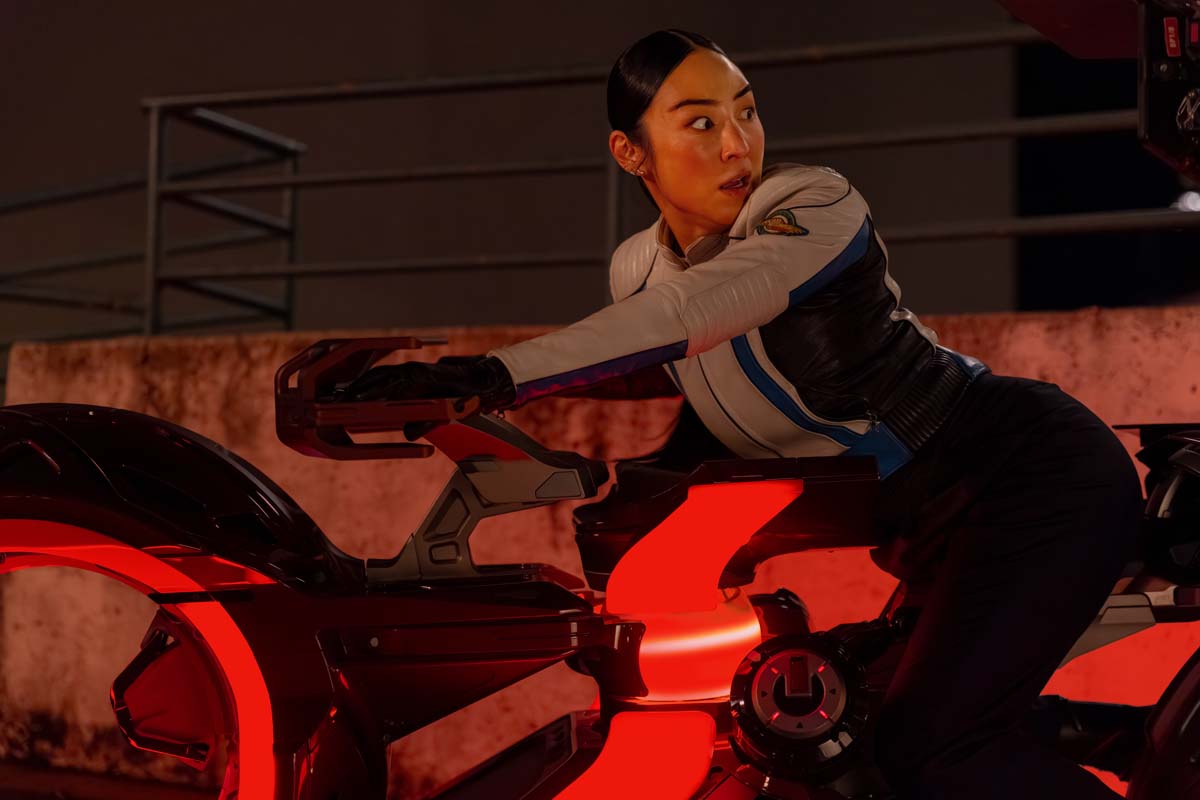
The whole third act, as I alluded to a little bit earlier, was a little tricky to put it all together the way it ended up in the final film, because when you have all these things happening at once, there are a lot of opportunities to move stuff around and have different things happen at different moments.
Like with a lot of action films, it was a lot longer. A lot more running. There was a moment where the drones are launched and they’re searching. The recognizer launches a bunch of drones into the sky, and there are all these ribbons flowing.
It was this beautiful visual sequence that was a lot longer: the hunt for Eve. We even storyboarded and prevised a handful of different extended portions of her evading them. Unfortunately - whether it was budgetary or scheduling - some of those things were dropped.
Eventually we figured out this dance between the interactions on the grid and what’s happening in the sky. All these jets coming in to support the attack. The people in Encom tower are trying to hack into Dillinger’s grid, then Eve running to buy a little bit more time for the hack.
It was a challenging dance, but we figured out a way to maneuver stuff around to make sure that it was happening in a believable amount of time and not delay the gratification of this encounter between Ares and Athena.
The hardest part about that whole thing is the tone of the ‘82 grid and the pace - how slow the interaction between Ares and Flynn is. It just takes a long time to come to the crux of that interaction.
A lot was cut from sequence and bouncing the placement of those scenes off of this massive destruction of the city was the hardest thing to navigate. But I think we ended up in a pretty good spot where it doesn’t feel sluggish.
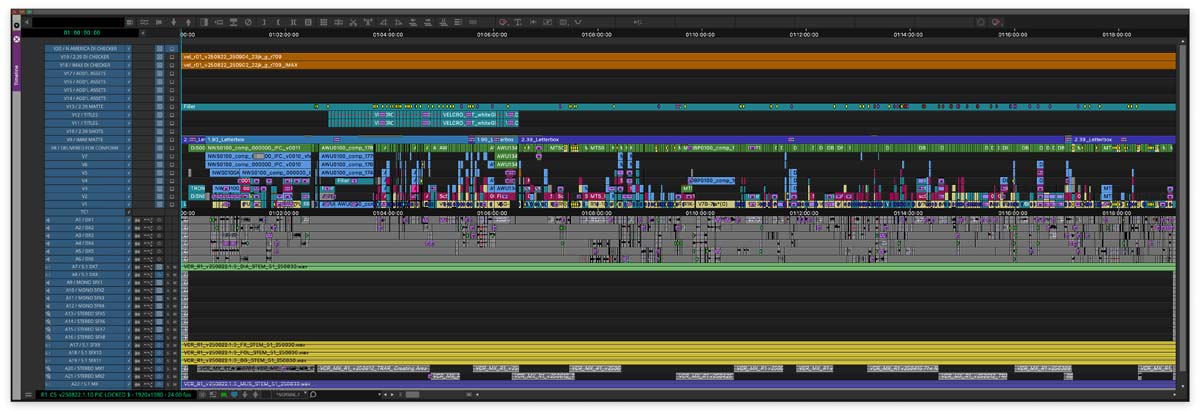
Avid timeline from Tron Ares
Is there anything you want to talk about?
With a movie like this, it takes so much time and energy and support from so many amazing people along the way. We all work our butts off to make sure that this is a movie that people are going to love and enjoy. It was a really fun time in the cutting room from top to bottom.
Everybody was great. I love and respect the time that I had on this movie, and I hope that anybody that goes out and sees this movie has as much fun watching it as my team and I had making it.
This is a hard industry to work in and long hours. We had a lot of a lot of fun in the cutting room. I think that’s reflected in the movie we made.
Tyler, thank you so much for your time. I really appreciate you chatting with Art of the Cut about Tron Ares.
Thank you so much, Steve.
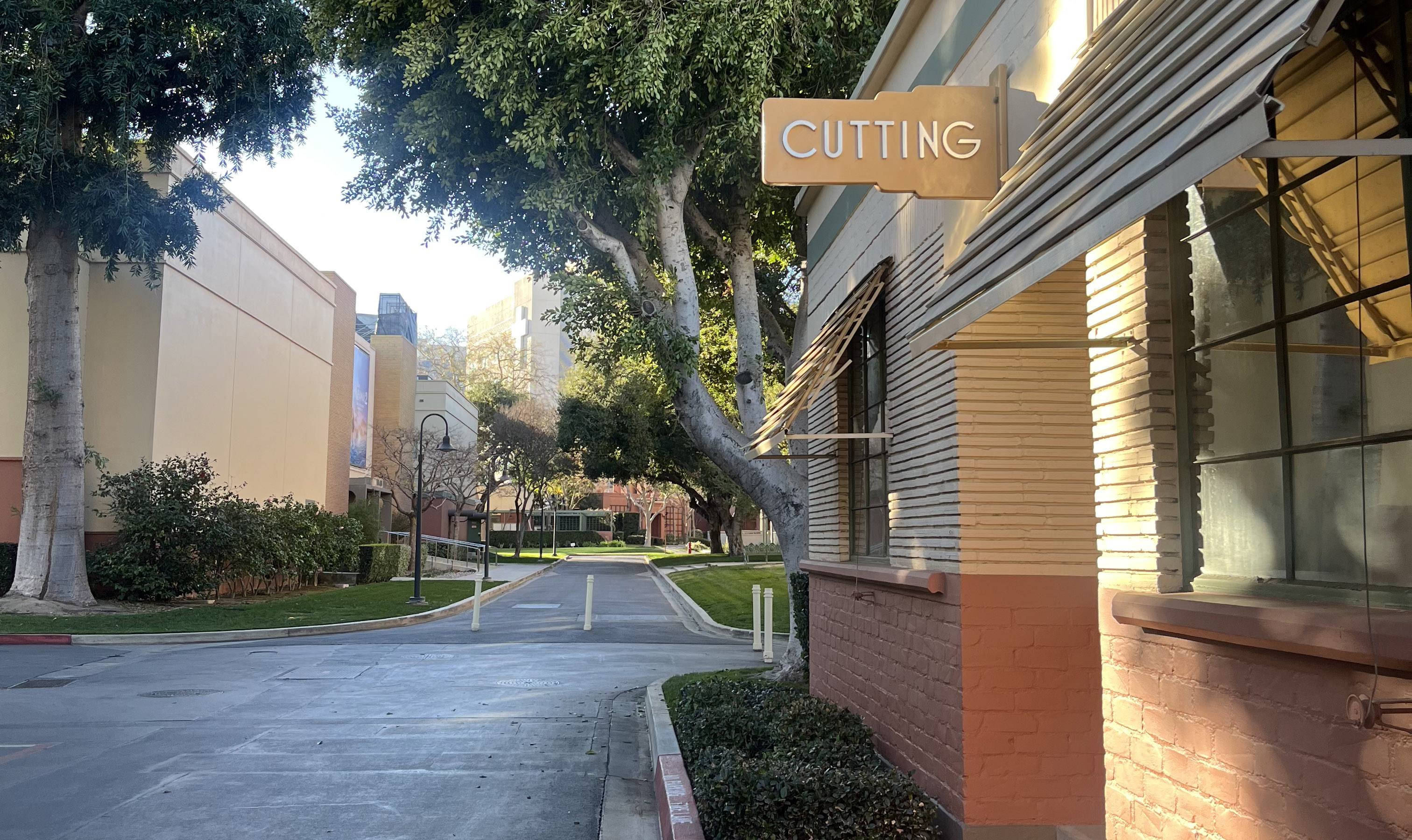
Cutting building on the lot








